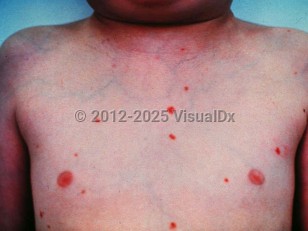Sinus histiocytosis with massive lymphadenopathy
Synopsis

Rarely, Rosai-Dorfman disease may be associated with other diseases including large B-cell lymphoma, myelodysplastic syndrome, plasmacytoma, idiopathic hypereosinophilic syndrome, Hodgkin lymphoma, sickle cell disease, and giant cell hepatitis. Other associated dermatologic conditions reported in the past include mycetoma, morphea, erythroderma, and Langerhans cell histiocytosis.
The etiology is not fully understood. It has been speculated that the initial histiocytic proliferation could be a result of an asymptomatic chronic infection or an abnormal exaggerated immune response to yet unknown antigen(s). Human herpesvirus 6 (HHV6) has been isolated from the involved tissue of some patients. Raised Epstein-Barr virus (EBV) and herpes simplex virus (HSV) antibody titers have also been reported. Associations with Klebsiella, Brucella, parvovirus B19, and cytomegalovirus have been suggested. Rosai-Dorfman disease has also been reported in HIV-infected individuals.
About one-third of patients with Rosai-Dorfman disease have mutually exclusive mutations in KRAS and MAP2K1.
Treatment is typically not necessary as the disease is self-limiting in most cases. Treatment is mainly needed to halt the natural progression only in a minority of patients where massive nodal or extranodal enlargement interferes with organ function or threatens life. The ideal treatment for Rosai-Dorfman disease should be tailored to the patient's individual situation.
Codes
D76.3 – Other histiocytosis syndromes
SNOMEDCT:
34287003 – Sinus histiocytosis with massive lymphadenopathy
Look For
Subscription Required
Diagnostic Pearls
Subscription Required
Differential Diagnosis & Pitfalls

Subscription Required
Best Tests
Subscription Required
Management Pearls
Subscription Required
Therapy
Subscription Required
References
Subscription Required

